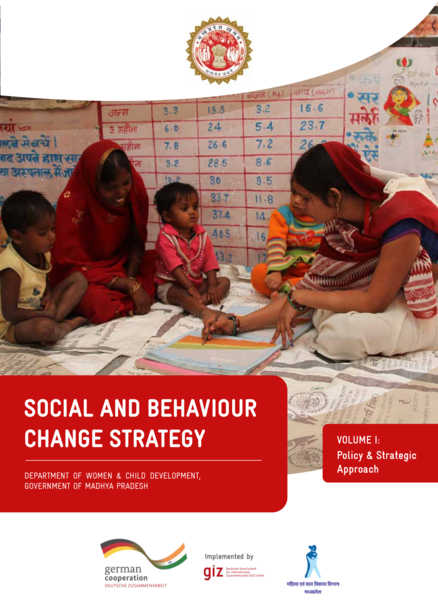Social and Behaviour Change Strategy. Volume I: Policy & Strategic Approach
New Delhi: Deutsche Gesellschaft für Internationale Zusammenarbeit (GIZ) (2022), 127 pp.
Contains photos, acronyms p. iv-v, bibliogr. pp. 126-127
"The Government of Madhya Pradesh is committed to ensure the overall development of all its residents, especially women and children. The Department of Women and Child Development (DWCD) works to sustainably improve health and nutrition outcomes for women of reproductive age and children below 6 years, enable holistic development and protection of children and ensure safety, equity and empowerment of women. The department implements the Integrated Child Development Services (ICDS) scheme for improving maternal and infant nutrition and health. It also implements the Integrated Child Protection Scheme (ICPS) and various other schemes and programmes for health, gender equality and women empowerment. Over the years, a lot of progress has been made. However, there are still a few indicators that are not doing well as expected. Census 2011, National Family Health Survey – 4 (2015-16) and NFHS-5 (2019-21) have found that low sex ratio, lack of women empowerment, experiencing gender-based violence, substance abuse, low female literacy, child marriage and small landholdings are some of the determinants of poor health and empowerment of women and children. Individual and community behaviours, attitudes, social norms and practices are some of the reasons for such indicators.
To bring about an improvement in these indicators and positively transform the status of women and children in Madhya Pradesh, a comprehensive state-specific social and behaviour change (SBC) strategy has been developed for DWCD. This strategy is supported by the recommendations provided in the department’s other policies. The state’s Nutrition Policy (2020-30) emphasizes on the importance of designing SBCC plans in local dialects for its acceptability and greater involvement of the community. The centre’s Poshan Abhiyan which DWCD follows stresses on community mobilisation and behaviour change, highlighting the need to take-up sustained efforts requiring multi-pronged approach and bring grass-root synergy and convergence. The state’s Child Protection Policy (2020) also highlights the need to build awareness and stakeholder capacities to strengthen implementation and the enabling environment to ensure child well-being and protection. This document details the SBC strategy which includes thematic area-wise priority and desired behaviours that should be practised by the target groups for improved indicators, barriers and enablers to its adoption, key messages to be communicated and strategic approach and interventions that will facilitate positive change." (Introduction)
To bring about an improvement in these indicators and positively transform the status of women and children in Madhya Pradesh, a comprehensive state-specific social and behaviour change (SBC) strategy has been developed for DWCD. This strategy is supported by the recommendations provided in the department’s other policies. The state’s Nutrition Policy (2020-30) emphasizes on the importance of designing SBCC plans in local dialects for its acceptability and greater involvement of the community. The centre’s Poshan Abhiyan which DWCD follows stresses on community mobilisation and behaviour change, highlighting the need to take-up sustained efforts requiring multi-pronged approach and bring grass-root synergy and convergence. The state’s Child Protection Policy (2020) also highlights the need to build awareness and stakeholder capacities to strengthen implementation and the enabling environment to ensure child well-being and protection. This document details the SBC strategy which includes thematic area-wise priority and desired behaviours that should be practised by the target groups for improved indicators, barriers and enablers to its adoption, key messages to be communicated and strategic approach and interventions that will facilitate positive change." (Introduction)
1 Introduction,2
2 Methodology, 3
3 Limitations, 5
4 Goal & Objectives of the SBC Strategy, 7
5 Thematic Areas, 7
6 Priority Behaviours & Barriers and Enablers, 8
Nutrition, Health & Hygiene -- Child Protection -- Women Safety & Empowerment
7 Strategy, 36
Building Blocks: Strategic Approach For SBC -- Key Messages: Nutrition, Health & Hygiene -- Child Protection -- Women Safety & Empowerment
8 How to Use this Document, 70
Annexures I-XIV, 75
2 Methodology, 3
3 Limitations, 5
4 Goal & Objectives of the SBC Strategy, 7
5 Thematic Areas, 7
6 Priority Behaviours & Barriers and Enablers, 8
Nutrition, Health & Hygiene -- Child Protection -- Women Safety & Empowerment
7 Strategy, 36
Building Blocks: Strategic Approach For SBC -- Key Messages: Nutrition, Health & Hygiene -- Child Protection -- Women Safety & Empowerment
8 How to Use this Document, 70
Annexures I-XIV, 75
